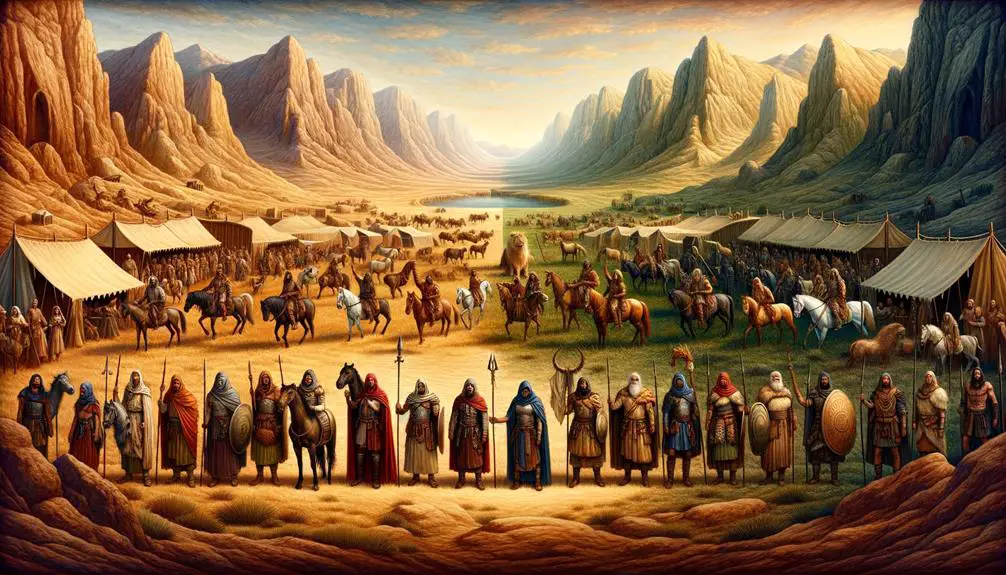Gad, a lesser-known biblical figure, holds secrets to ancient tribal dynamics and spiritual legacies that beckon further exploration.

Who Was Gad in the Bible
Imagine you're tracing your ancestry and stumble upon a figure named Gad, one of the lesser-known sons of Jacob in the Bible. You'd likely find Gad's story intertwined with the complexities of family dynamics, tribal legacies, and prophetic blessings, offering a unique lens through which to view the ancient narratives.
As you explore Gad's contributions and the tribe that bore his name, you'll uncover a mosaic of battles, allegiances, and spiritual insights. This journey into Gad's life and legacy not only highlights his significance in biblical history but also prompts a deeper consideration of the roles lesser-known figures play in shaping our understanding of the past.
Key Takeaways
- Gad was one of the twelve sons of Jacob, named after the Hebrew word for 'fortune' or 'luck'.
- He founded the Tribe of Gad, known for its military prowess and pastoral economy.
- The tribe settled east of the Jordan River, contributing to Israel's defense and prosperity through strategic geography.
- Gad's legacy is prominent in biblical narratives and prophecies, indicating his significant role in Israelite history.
The Origins of Gad

The figure of Gad originates as one of the twelve tribes of Israel, named after the seventh son of Jacob and Zilpah, Leah's maidservant, showcasing a complex lineage within Biblical narratives. Gad's etymology traces back to the Hebrew verb *gadad*, meaning 'to cut' or 'divide,' signifying Gad's potential role in dividing or allocating land among the tribes. This interpretation aligns with the tribe's historical significance in territorial assignments and military exploits, suggesting a foundational aspect of Gad's identity tied to land and its division.
Further exploration into Gad's etymology reveals a dual meaning with the Hebrew word *gad*, translating to 'fortune' or 'luck.' This lexical ambiguity enriches Gad's cultural significance, portraying him not only as a figure associated with territorial conquests but also as a symbol of fortune and providence within the Israelite community. This duality reflects the multifaceted nature of biblical figures, where names encapsulate character traits, destinies, or divine blessings.
Gad's cultural significance extends beyond his immediate narrative, influencing subsequent generations and interpretations. His name and story resonate within the broader context of Israelite history, embodying themes of survival, adaptation, and prosperity. As scholars delve into Gad's origins, they unravel layers of historical, linguistic, and theological implications, shedding light on the intricate tapestry that forms the biblical account of the tribes of Israel.
Gad's Family Dynamics
Gad's family dynamics, rooted in the complex socio-religious fabric of ancient Israel, reveal intricate relationships and societal norms that influenced his role and legacy. Within this context, Gad's upbringing and the parental influence he experienced are crucial to understanding his development and the decisions that shaped him.
- Parental Influence: Gad was one of the twelve sons of Jacob, making him a member of a highly influential family within the Israelite community. His mother, Zilpah, was Leah's handmaid, which positioned Gad in a unique socio-familial context. The dynamics between Leah, Zilpah, and Jacob undoubtedly affected Gad's upbringing, imbuing him with a sense of resilience and adaptability.
- Sibling Relationships: As part of a large family, Gad's interactions with his siblings, especially those born of Leah and her handmaid Zilpah, played a significant role in his development. These relationships likely fostered a competitive yet cooperative environment, shaping Gad's character and his approach to leadership within the tribe.
- Socio-Religious Context: Gad's family was deeply entrenched in the evolving religious practices of ancient Israel. This environment, marked by covenantal relationships with God and adherence to emerging rituals and laws, influenced Gad's spiritual development and his understanding of his role within the broader community.
Analyzing Gad's family dynamics offers a window into the socio-religious milieu of the time, highlighting how parental influence and sibling relationships within a complex family structure impacted his life and legacy.
The Tribe of Gad

Descendants of Gad, one of Jacob's twelve sons, formed a tribe known for its strategic military prowess and territorial ambitions, reflecting the complex narratives of inheritance and identity within ancient Israel. This tribe's location east of the Jordan River offered unique opportunities and challenges for its economy and cultural practices. Gad's economy, largely pastoral, benefited from the fertile lands suitable for livestock. The tribe's wealth in cattle, sheep, and goats wasn't only a measure of economic prosperity but also a critical element in their social and religious lives.
The economic success of the Gadites facilitated a lifestyle that allowed them to engage deeply with their cultural rituals. These rituals, often centered around their livestock, served as a reminder of their covenant with God, reinforcing their identity and cohesion as a tribe. Sacrificial offerings, a cornerstone of these rites, underscored the Gadites' reliance on and gratitude towards divine providence. Moreover, their rituals reflected a broader cultural milieu of ancient Israel, where festivals and religious observances played a pivotal role in maintaining the social fabric.
As you delve into the history of the Tribe of Gad, you encounter a narrative that's deeply intertwined with the land they inhabited and the economic practices that sustained them. Their story is a testament to the adaptability and resilience of ancient Israelite tribes, navigating the challenges of their environment while maintaining a rich tapestry of cultural rituals that defined their communal and spiritual identity.
Gad in Biblical Narratives
As you explore Gad's presence in biblical narratives, it's crucial to examine the multifaceted role this tribe plays, starting with its distinct tribal identity. Understanding Gad in the context of prophecies sheds light on its significance within the broader biblical story, revealing layers of meaning often overlooked.
Lastly, Gad's land allotment isn't just a historical footnote but a key to comprehending the tribe's social, economic, and spiritual landscapes within the ancient Near East.
Gad's Tribal Identity
Delving into the biblical narratives, one finds that the tribe of Gad emerges as one of the twelve tribes of Israel, characterized by its unique identity and role within the larger Israelite community. This tribe's identity is deeply intertwined with Gad's descendants and the ancestral traditions they maintained.
To understand Gad's tribal identity more thoroughly, consider these aspects:
- Historical Origins: Gad was one of Jacob's sons, whose descendants formed this tribe, adhering to specific ancestral traditions.
- Territorial Claims: They settled on the eastern side of the Jordan River, a decision impacting their lifestyle and interactions.
- Cultural Significance: Their unique practices and beliefs, rooted in their history and geography, contributed to the rich tapestry of Israelite culture.
Analyzing these elements offers insights into the integral role of Gad's tribe within the collective narrative of the Israelites.
Gad in Prophecies
Exploring the biblical narratives, one finds that the tribe of Gad occupies a notable position in various prophecies, offering insights into its future and the broader destiny of Israel.
Gad's visions, as recounted in the texts, serve as a cornerstone for prophetic interpretations, embodying a rich tapestry of foresight and divine guidance. These prophecies, woven into the fabric of biblical history, underscore Gad's integral role within the collective fate of the Israelite tribes.
Through a scholarly lens, one discerns the nuanced layers of meaning behind these forecasts, each revelation shedding light on the trajectory of Gad's descendants and their enduring legacy within the annals of biblical prophecy.
This analytical journey through Gad's prophetic landscape illuminates the depth and complexity of its contributions to Israel's storied past.
Gad's Land Allotment
In biblical narratives, the allotment of land to the tribe of Gad emerges as a significant event, highlighting their strategic and geographical importance within the nation of Israel.
- Gad's Geography: Situated east of the Jordan River, Gad's territory was characterized by its varied landscapes, from fertile valleys to rugged highlands. This diversity played a crucial role in the tribe's economic and defensive strategies.
- Agricultural Practices: The fertile areas within Gad's land supported a range of agricultural activities. These included the cultivation of grains, vineyards, and the raising of livestock, which were essential for the tribe's sustenance and prosperity.
- Strategic Importance: Gad's geographical position provided a buffer zone for Israel against eastern invaders. Their land's topography offered natural defense mechanisms, enhancing the overall security of the nation.
Key Battles and Contributions
You'll find that Gad played a pivotal role in various military engagements, a fact underscored by the tribe's documented strategies and victories.
Their contributions, alongside the prophecies by Gad, shaped the course of Israelite history significantly.
Analyzing Gadites' strategic victories throws light on their military acumen and the impact of divine guidance on their endeavors.
Gad's Military Role
How did Gad's military role shape key battles and contributions in biblical accounts? Gad's leadership and military tactics were pivotal, often determining the outcomes of conflicts. Here's an analysis:
- Strategic Deployment: Gad's tribe was known for their strategic placement on the battlefield, which maximized their impact against adversaries.
- Exceptional Warriors: Under Gad's leadership, his tribe cultivated a reputation as formidable warriors. Their skills and bravery in combat significantly contributed to their successes.
- Tactical Innovations: Gad's military tactics, including ambushes and surprise attacks, were revolutionary for their time. These strategies often turned the tide in close battles, showcasing Gad's understanding of warfare dynamics.
Gad's military acumen not only secured victories but also underscored the importance of leadership and strategy in biblical narratives.
Prophecies by Gad
While Gad's military prowess is well-documented, his role as a prophet also significantly influenced key battles and contributions through divine foresight. Gad's visions provided strategic insights that were unparalleled, demonstrating a prophetic accuracy that few could match.
These revelations weren't only pertinent to immediate military tactics but also had long-term implications for the nation's trajectory. His guidance often came at critical junctures, offering clarity amidst uncertainty.
This ability to foresee and interpret divine will underscored the significance of Gad's contributions beyond the battlefield. His prophetic insights ensured that decisions weren't solely based on human wisdom but were informed by a higher understanding, thereby shaping the course of events in a manner that aligned with divine purposes.
Gadites' Strategic Victories
The strategic victories of the Gadites, marked by key battles and significant contributions, underscore their critical role in shaping the historical and military landscape of their era. Gad's resilience and leadership qualities were evident in:
- Defensive Strategies: Their ability to fortify and defend their territories against external threats showcased their strategic foresight and military prowess.
- Offensive Maneuvers: Gadites excelled in conducting offensive operations that expanded their influence and secured vital resources for their tribe.
- Alliances and Diplomacy: They demonstrated a keen understanding of the political landscape, forging alliances that enhanced their security and standing among neighboring tribes.
Analyzing these aspects reveals the Gadites' sophisticated approach to warfare and governance, emphasizing their significant contributions to their society's survival and prosperity.
Gad's Prophetic Blessings
In biblical narratives, Gad's prophetic blessings reveal a multifaceted character, embodying both promise and struggle. Gad's foresight and the subsequent interpretations of his blessings offer a deep well of insights into his role and the broader theological themes within the scripture. These blessings, articulated through visions and prophecies, navigate the fine line between divine promise and the earthly challenges his descendants would face.
The analysis of Gad's blessings uncovers a dual theme of valor and vulnerability. On one hand, the blessings foresee Gad's descendants as warriors, characterized by their strength and determination to overcome adversaries. This aspect emphasizes the tribe's resilience and their divine-endowed capacity to secure their territory against encroachments. On the other hand, these prophecies don't shy away from acknowledging the trials Gad's lineage would encounter. The blessings, thus, serve not only as a foretelling of military prowess but also as a reminder of the inevitable struggles and the need for reliance on divine guidance.
Furthermore, the blessing interpretations enrich our understanding of the historical and spiritual landscape of Gad's time. They act as a mirror reflecting the socio-political tensions and the spiritual aspirations of the era. Through Gad's example, the narrative conveys critical lessons on faith, leadership, and the complexity of human-divine interaction.
Analyzing Gad's prophetic blessings, therefore, uncovers layers of meaning that extend beyond the immediate context, offering timeless insights into the nature of blessing, struggle, and the pursuit of divine favor.
Legacy and Symbolism

Exploring Gad's legacy and symbolism reveals a profound impact on cultural and religious narratives throughout history. Gad, one of the twelve tribes of Israel, embodies a unique set of virtues that have resonated through time, influencing both ancient and modern interpretations.
- Gad's Virtues: Gad's story and the blessings pronounced over his tribe emphasize resilience, courage, and loyalty. These virtues aren't only foundational elements in biblical narratives but also serve as moral compasses in contemporary discussions on ethics and leadership. Gad's example encourages you to face challenges with bravery and to remain steadfast in your commitments.
- Cultural Impact: The symbolism of Gad extends beyond religious texts, influencing art, literature, and historical discourse. In medieval and renaissance art, Gad is often depicted as a warrior, symbolizing the tribe's martial prowess and protective nature. This portrayal has shaped perceptions of divine protection and justice in Western culture.
- Modern Interpretations: In today's context, Gad's legacy is interpreted through various lenses, including psychological, sociological, and theological frameworks. Scholars and theologians analyze how Gad's virtues can address contemporary issues, such as conflict resolution, community building, and individual moral development. This multifaceted approach ensures Gad's relevance in a modern world, bridging ancient wisdom with current human experiences.
Frequently Asked Questions
How Has Gad Been Represented or Depicted in Modern Art and Literature Outside the Traditional Biblical Context?
In exploring how Gad's symbolism has evolved in modern art and literature, you'll find that contemporary interpretations often diverge from traditional biblical narratives.
Artists and writers reimagine Gad, integrating him into narratives that reflect modern values and concerns. This creative freedom allows for a broader discussion on faith, identity, and cultural heritage.
Are There Any Specific Prayers or Rituals in Judaism or Christianity That Are Uniquely Associated With Gad or Invoke His Name for Protection or Blessings?
You won't find specific prayers or rituals in Judaism or Christianity uniquely associated with Gad, nor ones that directly invoke his name for protection or blessings. This absence likely stems from the broader focus on collective worship and the key figures central to these faiths, rather than on tribal characteristics or Gad symbolism.
The emphasis in religious practices remains on more universally recognized figures and principles rather than on individual tribal identities.
What Are the Major Archaeological Discoveries, if Any, That Have Been Linked Specifically to Gad or the Territory Associated With His Tribe?
When exploring archaeological findings linked to ancient tribes, it's fascinating to note that discoveries specifically connected to Gad's lineage or the tribal boundaries of his people are rare.
This scarcity challenges researchers to piece together historical narratives from limited evidence. The ongoing quest to uncover artifacts or inscriptions directly associated with Gad's tribe underscores the complexity of tracing the origins and movements of ancient groups through the archaeological record.
How Do Different Jewish and Christian Denominations Interpret Gad's Role and Significance Differently in Their Religious Teachings and Practices?
You'll find that Jewish and Christian denominations have varied interpretations of Gad's role and significance, largely due to differences in theological emphasis and scriptural interpretations.
In Judaism, Gad's lineage often symbolizes strength and fortune in traditional teachings, while in Christianity, his story might be seen more through a lens of spiritual symbolism, reflecting broader themes of faith and providence.
This divergence highlights the rich tapestry of religious thought surrounding this biblical figure.
Has Gad Been a Popular Name Among Jewish and Christian Communities Throughout History, and What Are Its Variations in Different Cultures and Languages?
You're exploring the essence of names, where Gad's etymology and name symbolism serve as your compass. This journey reveals that Gad hasn't consistently been a popular choice among Jewish and Christian communities. Its presence varies, reflecting cultural and linguistic landscapes.
Variations of Gad, echoing through history, offer a rich tapestry of identity and belief. Analytically, one observes the name's fluctuating significance, shaped by tradition and adaptation across cultures.
Conclusion
In the tapestry of biblical history, Gad emerges as a vibrant thread, weaving together tales of survival, valor, and divine favor. As you've journeyed through the life and legacy of Gad, you've navigated the complex family dynamics, pivotal battles, and the rich symbolism that colors his story.
Gad's narrative, embroidered with prophetic blessings, showcases the enduring spirit of his tribe. This exploration not only enriches your understanding but also illuminates the intricate patterns of faith and resilience in the biblical saga.


Sign up